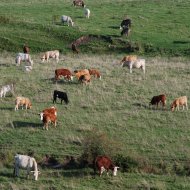Feed efficiency project reaches milestone

Whilst the programme is focused on the Limousin breed, all major breeds in UK beef herds should benefit from the findings.
A groundbreaking beef feed efficiency programme has now completed data collection for its first batch of cattle, marking an important milestone in the project.
Funded by Defra and the Agriculture and Horticulture Development Board (AHDB), the project aims to develop standard recording approaches and create a network of industry recording units.
An estimated breeding value for feed efficiency is also in development and the program hopes to aid genetic selection in the Limousin breed and, eventually, other cattle breeds.
Whilst the programme is focused on the Limousin breed, all major breeds in UK beef herds should benefit from the findings.
The initial phase of the project is underway and beef cattle from suckler and dairy herds are being tested at Scotland's Rural College (SRUC). The first batch is comprised of 93 Limousin-sired cattle ranging from eight to 11 months old.
Feed troughs used for the project are able to recognise electronic identification tags and continuously monitor the feed weight, recording the intake for each feeding.
Other factors measured are liveweight, back fat depth, carcase weight and classification.
In total, 500 cattle will be tested at SRUC before recording is rolled out to two or three specially equipped commercial farms.
AHDB is currently looking to purchase or loan Limousin or Limousin cross calves from dairy or beef dams that will be eight to 10 months old in mid-March.



 The RCVS has announced a new version of its 1CPD mobile app, with enhanced features for veterinary surgeons and veterinary nurses to record their continuing professional development.
The RCVS has announced a new version of its 1CPD mobile app, with enhanced features for veterinary surgeons and veterinary nurses to record their continuing professional development.